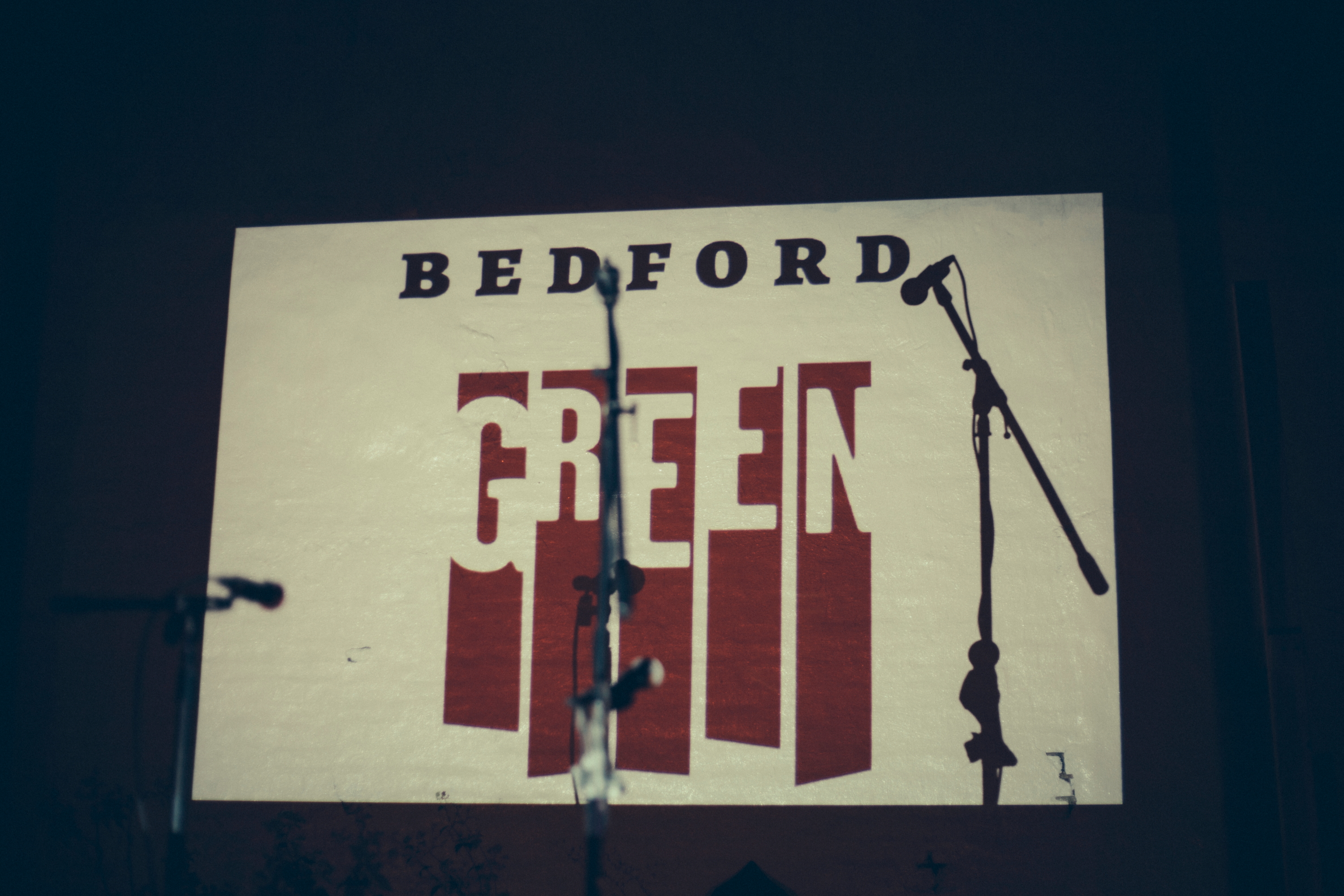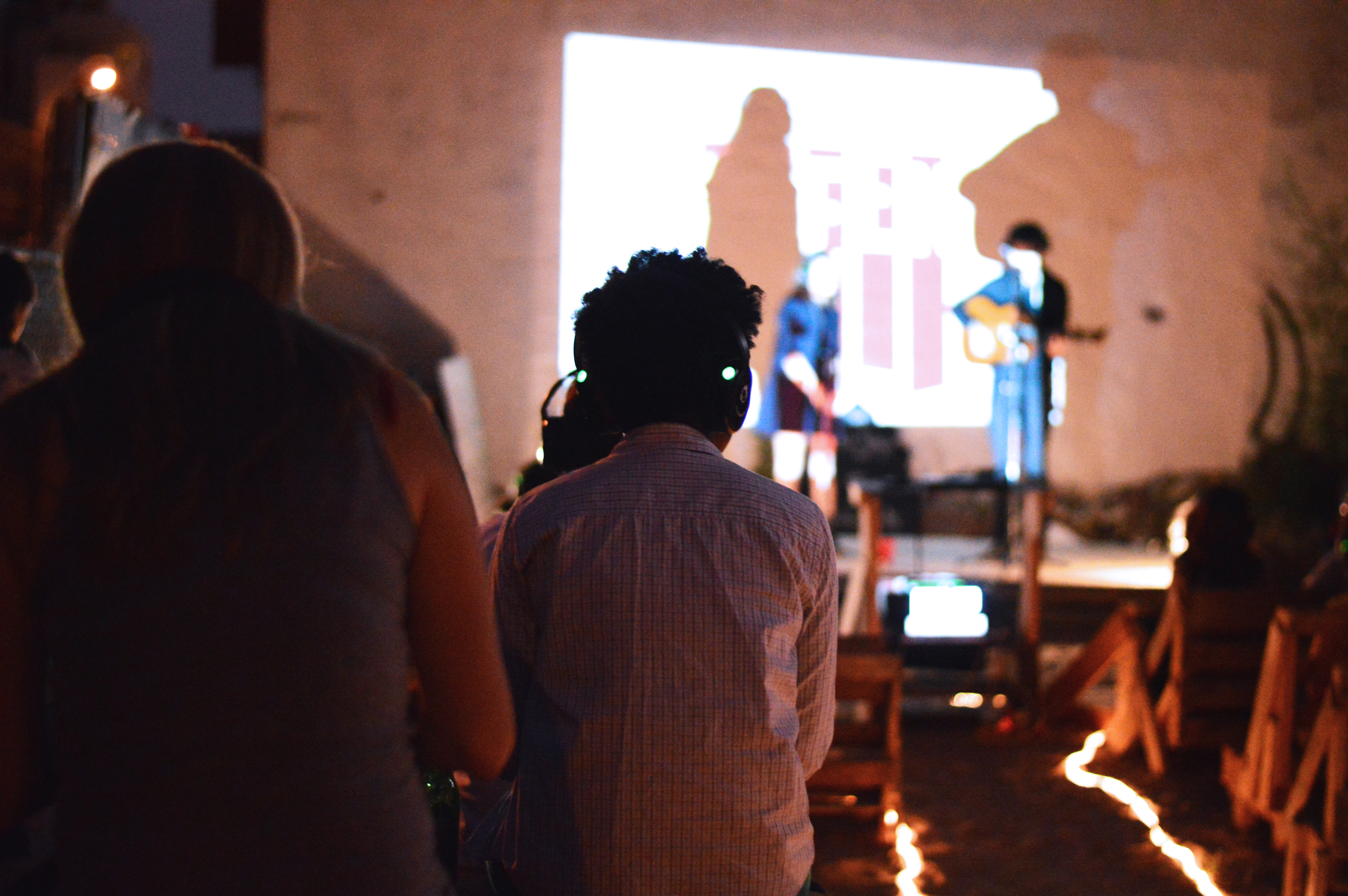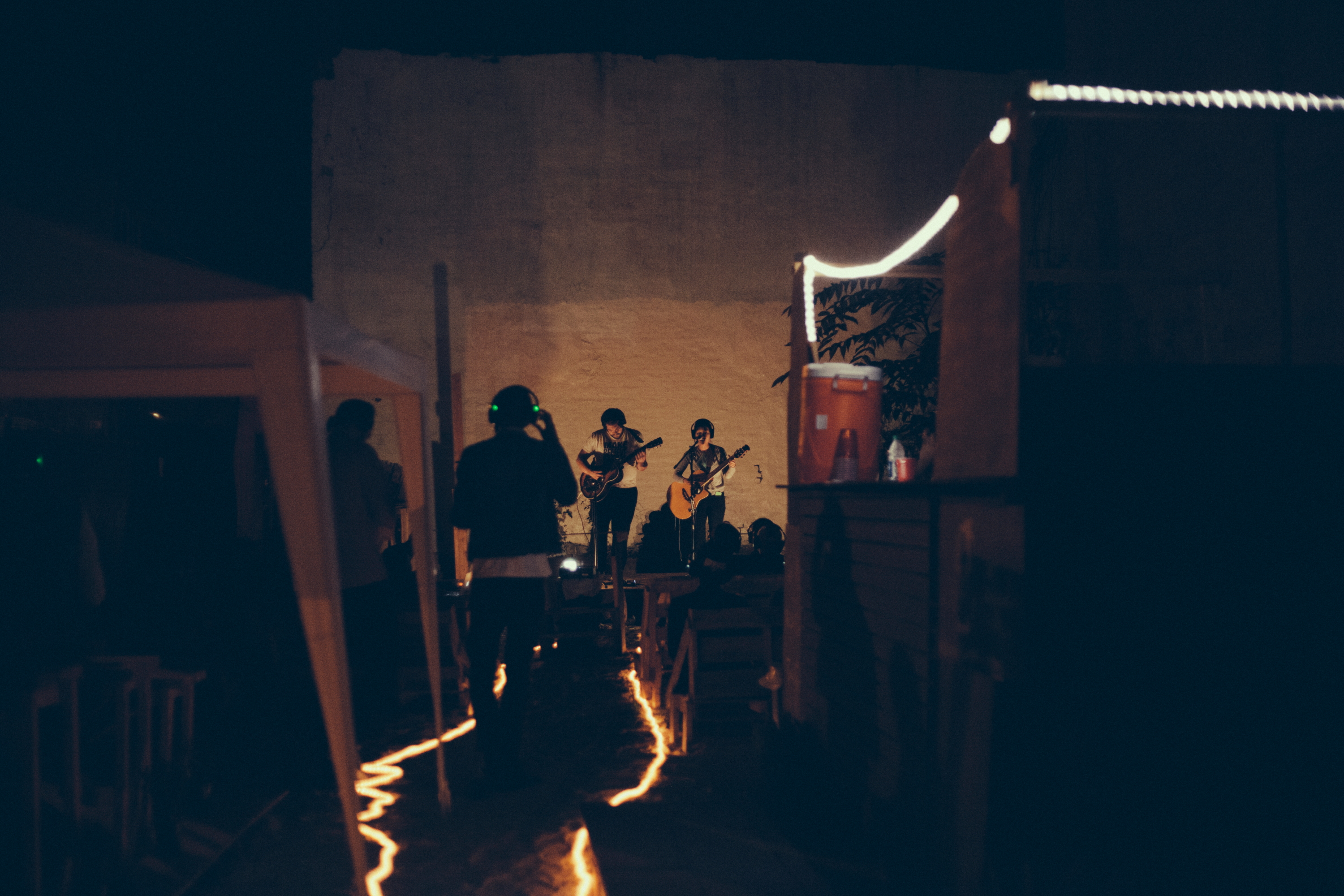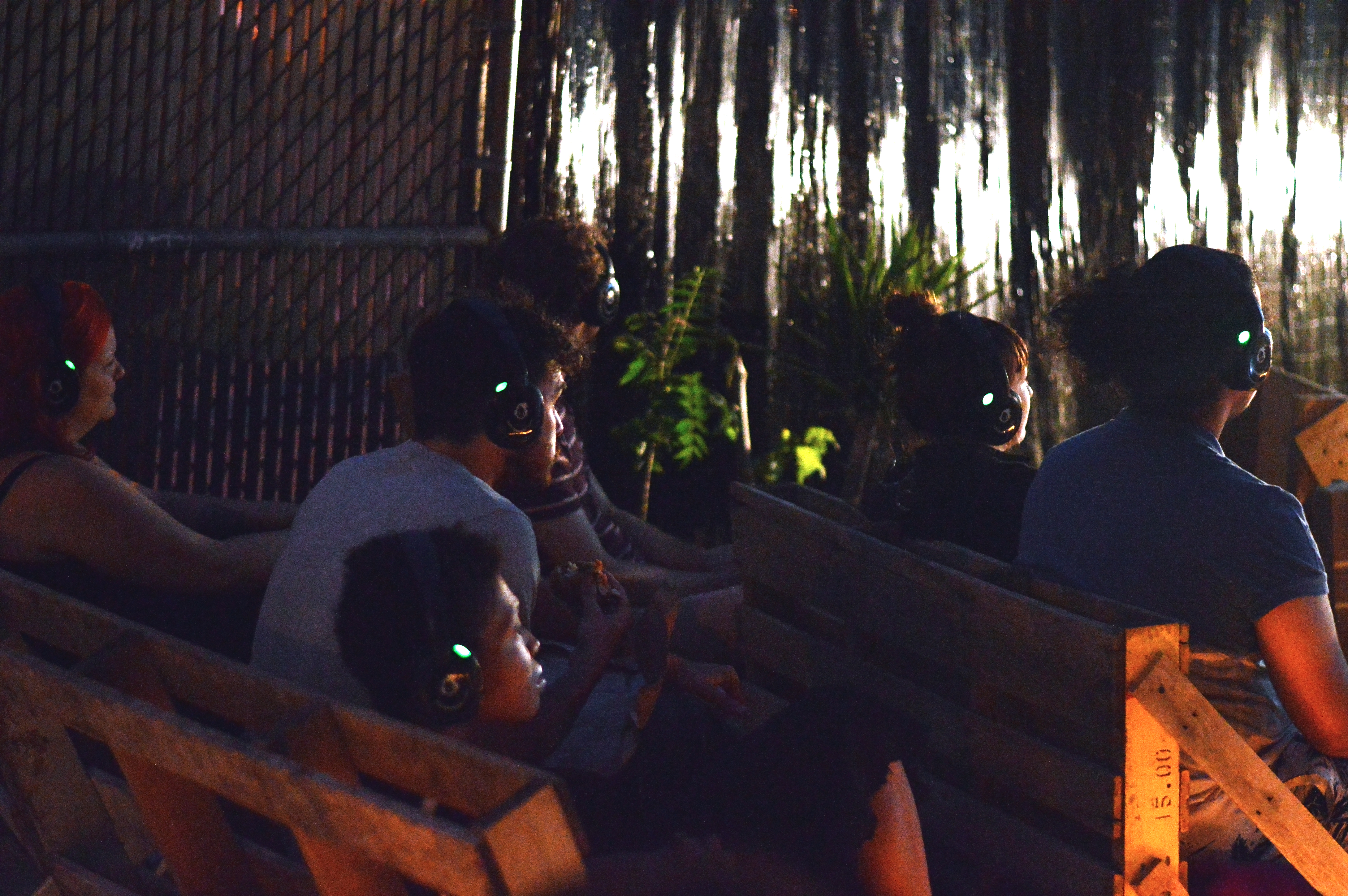NYC’s hottest multimedia experience, The Bedford Green Project, merges music and cinema into one mad experimental night of total artistic freedom, in the process redefining synesthesia – the state of mind when you can see the sounds and hear the colors. Funnily enough the people, who are destined to change for good the music and film climate in Bed-Stuy, Brooklyn come from jolly old London Town. Wayne Yardley and Daniel Morrow have years of showbiz experience, both behind the stage and on it, which finally came together as one revolutionary idea: to invite a band, plug everything in, even the drums, and let the audience submerge into a breathtaking sonic ocean, hearing every nuance of the performance in high quality stereo headphones. How does it work? Flowers In A Gun gets the answers straight from one of the father’s of the invention – Daniel Morrow.
How did the project start?
It started in August and we had a space, a pop-up venue. We didn’t have anything except for some Kickstarter money. We were a very exciting Kickstarter story, because we got the funding three hours before the deadline. As an example of our shoe string budget, there are shots on film of the neighbor next door to us, throwing us a cable for plug in electricity from his apartment, so we can have power for the night.
So it was the necessity that led to an invention?
It was a mixture of a lot of things actually. We had an idea before for a commercial space, so we looked around for an outdoor space that we can rent for a month or two. Then we obviously thought of the fact that we will be causing some noise outside. Wayne and I are close to the music industry for a long time – we have played in all the best and the worst venues in New York and London, you know. And we shared the same experience – in every venue there is always a problem with the sound. So when we came to our own project we were thinking of ways how to change the general idea. We didn’t want just the same standard thing when you have four walls, four bands, every night, in and out. We heard about something that was big in London – silent disco, which are parties that take place indoors, but with headphones on. It’s kind of fun and kind of strange, but we were “Wait a minute, how can we maybe do this for bands?”
So you are the pioneers of this approach, nobody else is doing it, right?
They tried it long time ago – The Flaming Lips did a concert 15 years ago. The technology wasn’t quite there, it was a bit of a flop and I think that may be one of the reasons that nobody tried it. But we tried it and it kind of fell into place. We thought: “Great! People have headphones, so we don’t have to have live drums, guitar amps”. We were happier than we thought we would be, because it just sounded high quality.
Do people enjoy the experience?
The first time I was very nervous. Having been in Brooklyn and played in many shows with lots of fantastic musicians, I asked a lot of them to come and play. The first band that did the show was a band called Lunifred Benjamin and I’ve always loved his stuff. So suddenly came to that day and it was like: “Oh, my God, this guy is gonna play and we don’t know what we’re doing!” But he was like: “Whow, this sounds great!” From that point on we were: “This is gonna be okay!” And we had the perfect screen for film projection – the next door neighbor had a huge white wall, so we just used that for showing films. That was something we wanted to do from the beginning, to see how well music and film can work together and ideally even like merge together. So you have a band and findwhatever the band is having in commonwith film or images, or some connection that have with film – with, music promos, or even better – to do short films themselves.
So the merging of film and music was a concept from the start?
That was the idea when started and now we’re pushing much more on that. We’re trying to find bands that have this kind of image content with them. For example the first event that we was are doing is with a band called King Holiday, who have done several short films and lots of images and they’ve done a little project in the Whitney Museum. We were doing three projection screens and three headphone channels. Kind of like the silent disco, where you can switch up, but in this instance you can have one screen over there doing one thing, you switch to headphone channel here and you look over there. It’s perfect for this kind of thing that we want do, because you come into the space and you’re already immersed in the world of this band. We think of it as a way to honor the artist – you’ll be surrounded by the artist in different musical and image ways. It’s kind of like going to an art gallery, where you can switch off – you can see that, then see an installation, switch up.
Are you planning an evening with the accent put on the films instead of the music?
We have bands and we have images around them, but also we’ll have film artists and have a night around them – music based around that film, or music that the director loves. There is actually a huge event that we have planned for early next year – a British director called Simon Blake. That is gonna be a fantastic night, because he has just worked with some amazing musicians, he used to make music promos for Sub Pop Records. His film has amazing music, hopefully we can do live the score. And it’s funny, you find every band, every music artist, really wants to be in film or is really inspired by film one way or another, while every film artist says: “Oh, I really wanna do music”. I have always wanted to be working somehow in film, so it’s really good to have the opportunity to merge the two things.
Yeah, in the last years people started to listen to music through their eyes…
That’s a good way to put it.
The coolest part is that guys from England are changing the music climate in Brooklyn, right?
That is nice, yeah. The other really exciting thing we’re doing is the live-streams between London and Brooklyn. My partner is now in London and he is teamed-up with a colleague, who does The Crypt Sessions. The Crypt Sessions is kind of a live venue in a basement, but they have some very good names playing there. The idea that we had was: “Wouldn’t it be cool if you’re sitting in London and kinda visit Brooklyn for the night?” Or you’re here and you’re kinda like: “Let’s be in London for the night”. The advantage for the artist in London are that they can play in New York for free. And we have a couple of bands here, that we’d like to feed back.
How did you end up in New York?
Oh, long story. The short version? I came from music and it was 10 years ago. I came to start a band here…The honest answer is I came for something new. How about you?
Oh, it’s a long story too. I guess the answer is the same – looking for something new.
It never actually disappears this feeling – you’re always looking for something new. We’re doing brand new things and we’re learning as we’re going. “Oh, this is working and this is not”, so we exchange this bit. I have been in music bands for a long time and I did sound engineering for a few years and a several years ago I helped a friend write the first ever live music venue guide book for New York. That meant going around 50-60 different venues in NYC. It was really great – you get to see how everybody does it and this is the biggest learning curve.
And you see what’s missing on the map?
Exactly. After that I did a promoter /engineer kind of job in a venue in Brooklyn called Matchless, so we had all this background– it’s obvious what the natural conclusion is and that’s really good. My partner Wayne Yardley has been in the music industry for ten years and he’s worked with CAA and Warner Brothers, he’s been in a big band – Animal Kingdom and played the biggest venues. Actually Wayne brought a ten year old dissertation, from when he was going to school on the merging of cinema and music. He has been thinking about this stuff for years and years. It seems like both of our timelines have gone like: “Oh these things lead to this.” Because he had most of the ideas and the concept behind it, while I had the technical-logistical side covered.
Why do you think, that are not more people trying in your direction?
You don’t make any money from it. It’s such a huge conceptual event to organize – you have to select which band you like and find a way to describe them what it is. When it comes off it’s a fantastic, but it’s much more refined – it’s not like a regular business, when you say: “You know what we have to do.” We know what we like and we get excited about it, but then we have to focus on: “Does it make sense as a business?” And if it doesn’t, doesthis matter? Silent disco is coming together now and becoming a successful thing. Roof top films too – where they do have movies and they do have a singer beforehand, but they’re not really merging them together. And there is bunch of other things like The Black Cab Sessions and Balcony TV and Sofa Sounds, when they’re saying: “We’re just gonna do our little thing and put it online.” and it’s really taken off. And we basically come from a place of: “What we would really like to see?” And we will see if it flies, as they say: “If it’s got legs”.
How do you select your venues?
You take a space and you say: “What can we make out of this space?” At the moment it looks like a piece of nothing, but maybe we can make it piece of something what we present. It’s a very exciting challenge to go and look around the area and say: “This space, what can it be, can it be something?” We found couple of spaces that hopefully we can use.
Whow! The spiritual underground.
Yeah, a space-ment. The other important thing to talk about is Bed-Stuy. From two years ago we said: “We wanna change up the world of music and film, but where are we gonna do it?” Living in Bed-Stuy so long – 7-8 years we saw how the neighborhood was so exciting in many ways, changing so quickly from a very run-down neighborhood, becoming where the artists are moving to, where the creative professionals are moving to. And it’s still happening now. There’s lots of bars, lots of restaurants, but there is no kind of music venue, there is no kind of cinema space. And when we started building the pop-up venue, we were even more convinced, because everybody was passing by and was: “What’s this gonna be, oh this is so exciting, what are you guys doing!” If we’ve done this in Williamsburg, people were gonna be like: “Oh, it going to be just another space, another thing.”It’s definitely a space for local musicians – King Holiday is a Bed-Stuy based band.
What is the biggest challenge that you’ve faced when preparing an event?
We had one of our most exciting events with Maria Stanisheva, she is a producer of a short animated film called “Father”, which I hear was quite big in Bulgaria, Croatia and France and have won so many awards in Europe, but it never had a screening in New York. We managed to organize a night to do that. Also Scott Rudd, who is very well renowned in Brooklyn, a wonderful singer-songwriter, agreed to play on the same night. We were: “This is gonna be the best night ever”. Then we wake up that morning, all ready to go, and we look at the weather forecast,– raining, raining, raining for all the hours. I ran down to search for a canopy, but it was such a large space to cover – it was kind of impossible. Finally, t was 6 o’clock and the event was at 7, so we started to try and put this huge tent up and everybody arrived and actually helped us build this thing. Scott arrived to play and we were: “Man, I don’t know, if we can do it”, but he was: “It’s all right – I’ll just play acoustic.” And we had 50 people crammed in this canopy and everybody loved it. We even got people standing out with umbrellas. It was really really nice night.







